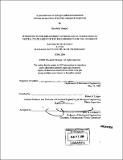A potential route to hydrogel multifunctionalization utilizing encapsulation of acrylate-conjugated streptavidin
Author(s)
Hempel, Elizabeth (Elizabeth L.)
DownloadFull printable version (1.121Mb)
Other Contributors
Massachusetts Institute of Technology. Dept. of Mechanical Engineering.
Advisor
Robert S. Langer.
Terms of use
Metadata
Show full item recordAbstract
Biologically active materials providing a range of applications from tissue engineering to microdevices have begun to revolutionize biomedical science. New chemistries, however, must be developed for functionalization of these materials with each different molecule. This paper explores a technique for developing multi-functional, biologically active hydrogels utilizing the high streptavidin-biotin binding affinity. Streptavidin was conjugated to acryl-PEG-N-hydroxysuccinimide, a commercially available molecule that allows chemical binding to poly(ethylene glycol) (PEG) diacrylate and dextran acrylate hydrogels. Such gels were made by photocrosslinking solutions of APN and streptavidin conjugated at various molar ratios, along with a gelling polymer under an ultraviolet (UV) lamp. Acryl group conjugation was confirmed through high performance liquid chromatography (HPLC) and mass spectrometry. Protein binding was assayed through the use of rhodamine-labeled streptavidin and fluorescent microscopy. Gels were incubated overnight in solution to determine diffusion. After 7 days, PEG showed no diffusion while dextran acrylate demonstrated 100% protein loss.
Description
Thesis (S.B.)--Massachusetts Institute of Technology, Dept. of Mechanical Engineering, 2006. Includes bibliographical references (p. 18).
Date issued
2006Department
Massachusetts Institute of Technology. Department of Mechanical EngineeringPublisher
Massachusetts Institute of Technology
Keywords
Mechanical Engineering.